This highly-desirable 1947 Triumph 1800 Roadster has been in “dry-storage” since 1972! These are rare cars and this one has quite a history. It’s listed on eBay in Skipton, United Kingdom on the southern edge of the beautiful Yorkshire Dales National Park. It’s not inexpensive, with the current bid price of £6,000 ($8,638) and six-and-a-half days left on the auction. But, you’re not likely to find another one, maybe ever.
The seller says that this “is a very early model – Chassis number 35 – and features fold-down window frames which were only fitted on the first 200 cars.” The 18TR was designed to try to take on Jaguar in the waning days of WWII. The car for sale here is in great condition from being stored since 1972, but there is some surface rust on the front wings (fenders, to us Yanks) which are the only part of the body that isn’t made of aluminum. The design is known for being a little bulbous as compared to some other attempts by other car makers of the time. It almost looks like a cartoon car if you’ve ever seen one in person. But, I think that’s what gives it such an endearing persona.
The car has “2 hubcaps with globe centres and one without”, so you’ll be searching for at least one of those, which may be a daunting task. I’m not sure what color/colour this car would have been originally, maybe some sort of gray? The seller says that this car “was first registered in 1947 by a member of the Anglo-Irish aristocracy living at Belle Isle Castle in County Fermanagh and was chauffeur driven. It was then bought by a farmer in the early ‘70s who rarely, if ever, used it but kept it in a dry haybarn – he is responsible for removing the paint but little else! He sold the car to my brother-in-law in 1972 since when it has resided unused in his garage.”
The “original Jaeger instruments” are all there but “it is missing the hood and ash braces although the metal frame is included with the car.” You should be able to have a new hood (or, convertible top, to us Yanks) made and the tired but otherwise-complete interior looks decent for being a 69-year old car.
The right-half of the bonnet (hood, to us Yanks) shows a dusty engine. Did you expect any less? Here is what it will look like. This is, somewhat ironically, a 1,776cc 4-cylinder with about 65 hp. The car also has a 4-speed column shifter. You’ll be joining the Triumph Roadster Club so you can find parts and for the camaraderie of the fellow club members; and to pick their brains during the restoration. This is a rare car and if a person had enough time, and money, they could do a bang-up restoration and you would almost be sure to have the only one at the next car gathering. They only made about 2,500 of these Triumph 1800 Roadsters. Is this a car that you could see yourself restoring and driving, or do you prefer the newer Triumph offerings?
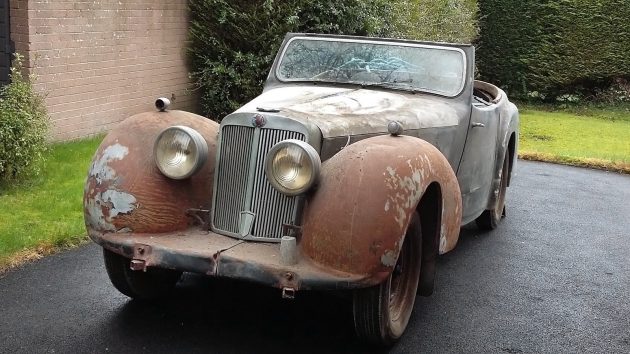
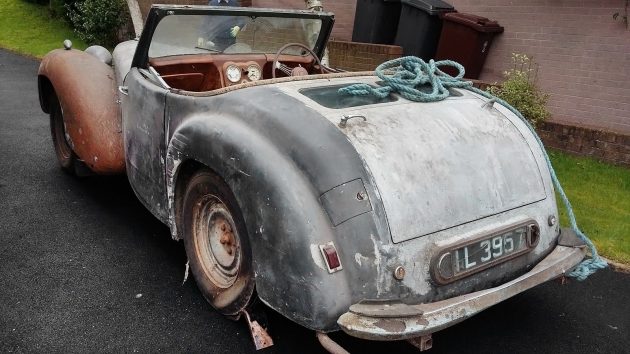
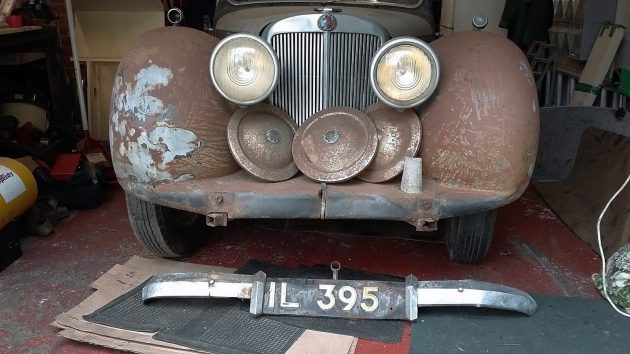
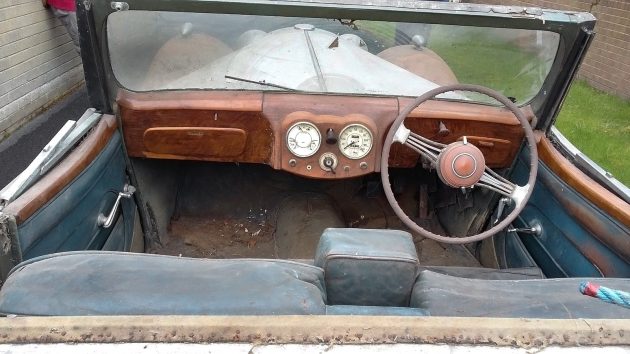
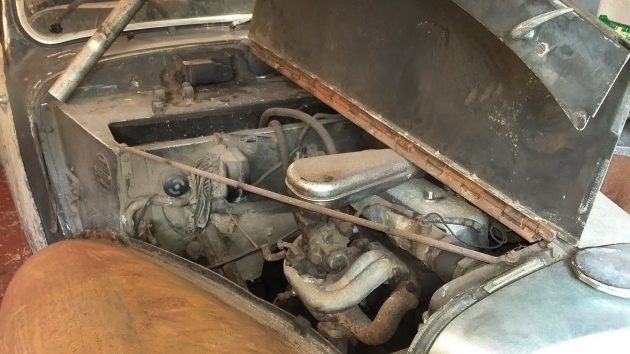


This will be an excellent project, looks very complete. I wonder if that engine found it’s way into the TR series?
Roger, the engine from the later 2000 roadster (visually essentially identical) was the Vanguard wet-liner engine that evolved into the TR2/3/4/4A engine.
I like it, though I am biased as a fan and owner of later Triumph roadsters…. I don’t suppose you’ll be going anywhere real fast in this one but it has charm.
There’s obviously a lot of work to be done to get this one back into shape but it does appear to be largely complete and not excessively rusted – which is a good starting point.
The hub-caps look very similar to the TR3/TR4 style with the Standard-Triumph globe in the middle? They are not that hard to find at all, either new reproductions or good originals.
WOW! I would love to have this as a project! Just beautiful. Wifevwould kill me though. But what a way to go.I would full restoration back to original. Doing a 65 Triumph Spitfire 4 right now
I think that World War Two had finished ‘waning’ by 1947, if my high school history classes served me correctly (although the UK was still having to rebuild infrastructure, clear rubble, and dispose of an unhealthy amount of UXO–the latter being an ongoing task to this day).
Just saw one of these at the South Central British Car Gathering last weekend. You do find them on this side of the pond as well. A few interesting features are the steel front wings with the rest of the body being aluminium and the rear “dickey seat” with the wind up rear screen. Love the looks!
Wonderful find, cool writeup Scotty, great idea including the “after” photos link. This would be worth the years it might take to restore it.
Love it! Reminds me of my 52 Riley drop head. But sadly, wrong hand drive ….
I like these, and no I haven’t seen one in person.
Can you install wire wheels?
Disc brakes?
150 horse power?
Can adults ride comfortably in the back?
Van, yes to the wires although I’ve never seen one with them. Discs–I understand TR3 discs can be adapted, although again, I haven’t seen it. 150 HP would take a HIGHLY tuned TR4A engine, but it’s possible. Finally, it depends on your definition of comfortable… :-)
It’s best if they were intimate before they got in I gues.
Greetings All,
This is one of the last timber framed bodies made by Triumph. Have always loved the lines and the rumble seat and rear windshield.
Mechanicals not a problem. Metal corrosion and wood rot, being a drophead can really surprise you cost wise.
Never have seen any panels for these available.
Not going to go fast with that four banger, I thought these were flatheads but that rocker cover says its OHC, in fact, someone correct me but I thought the 1800 was a flathead and the 2000 was the OHV engine.
Brilliant! I used to have a 2000 (actually 2088cc) back in England. Lots of people put in later TR motors, but regretted it when the values for original cars starting climbing.
I would love to have it, but only in my dreams as I couldn’t find the time for it.
It’s a great price at the moment, from what I recall prices in the £20Ks were typical a few years ago for a well turned out motor.
The wings are not at all scary, you won’t see a Triumph Roadster without some rust there – and I understand that they were made of steel because of their size, aluminium ones would just vibrate and crack.
Though I had the 2000, I believe the 1800 engine was somehow associated with Jaguar?
Not sure what the reference to fold-down window frames is about, the door windows have winders, and they all had the windows in the boot – my car was 1949, serial TRA995.
By the way, note that the gearshift and parking brake are on the right in this right-hand drive car, that’s so you can seat three across in comfort under cover.
Greetings All,
Allan, you may be right. I thought the engine was the one that Standard had made for the SSII, the four cylinder flathead that eventually, like the six cylinder, evolved into the OHV engine. Jaguar bought the tooling from SIr John Black’s company on at least the six, which later became the SS100 2.5 liter and later expanded to 3.5 liter. Not sure about the four.
Seem to remember the car was really designed by two different designers with one responsible for the front the other the rear. One was an employee of Jaguar.
Some people say it looks like two different eras of car when looking at the front and back. I think it works, but could benefit from a bigger engine and better brakes.
These aren’t making big money, so I’m doubtful having the original engine is as important as having one that runs and is a little more advanced in design.
Standard-Triumph not really known for their advanced engineering as the tended towards agricultural purposes and the autos came second.
Sir John Black, bless his heart, had already rejected SS’s/Harry Weslake’s designs on making the Ensign Standard 16-20HP series flathead into an OHV. Sir John didn’t see the need to continue making the six, so SS would be out an engine for their cars.
Luckily Walmsley and Lyons made an offer for the tooling and Black accepted but attempted to back out several days later but Lyons persisted the deal go through as the gentlemanly thing to do.
Sir John Black an interesting fellow but did not seem to be able to plan or design ahead for any length of time, which ultimately hurt Triumph in the long run.
Very impressive looking cars, other than high end products, I am not a British car guy but these are very cool. I had a neighbor in the late 70’s that had one he transplanted an American V6 and manual transmission in, added disc brakes and a modern suspension. Restored the balance of the car in an orignal style. It was a great car. These are pretty good size compared to other British roadsters in there class.
Hub caps look the same as the Vanguard of the early 50s
These are not rare cars, several show up on US eBay every year and frequently derelict examples can be found at swap/junk meets. Notable for being perhaps the last production car with a rumble seat.
Ah brakeservo, you are wrong, the 1800 and 2000 roadsters are very rare. Check the production figures first. Second, not many made it here to the US. I had a 47 RHD model 1800 that needed work but I sold it to buy a 49 RHD model 2000 that is in excellent condition. The 49 was imported from Luxembourg about 20 years ago. Again, they are hard to find in the US. I still have the model 2000. It’s been a great car, never let me down but it is pretty slow. The only thing I find on these cars is the brakes never felt right on either car, they like to pull to the left, I don’t know why. Both cars did this before and after a full brake job. The only other issue is it’s almost impossible to get in and out of the car. I leave the top down and jump out. There is no, none, zero, zip leg room but head room is ok even for me with the top up. I am tall, 6ft3 but even my wife at 5ft3 can not climb into the thing. Forget about climbing into the rumble seat unless you are a kid. Nobody seems to know what it is when I take it to car shows.
I’m sure you’re right Nessy. As I remember it, there were only 2000 1800s made, and 3000 2000s. I think the Triumph Roadster Club used to list less than 100 members in the states, and I’ve certainly never seen any here.
I never had a problem with brakes pulling to one side. I do recall that my car was a delight to slide around the corners, very controlled. I always used to hang the back out on the roundabout going into University – and the riders in the boot loved it!
Even at that time (1970), dickey seats were becoming unknown. I got stopped once by a young policeman on my way into University, and he was very apologetic, but said he had to stop me because I had people “sitting in the boot”! He took some convincing that the car was designed that way, but he agreed when he saw how the fold-down seats worked.
I have a customer that has one here in the US. Great little car he brought here from England . Right hand drive, runs and drives like new!
After the war pure aluminium was hard to get so magnesium/aluminium alloy was used for the early cars, much of it recycled from aircraft skins. I understand that many of these cars had the name of the panel beater written in pencil on the inside of the panels. Has anyone experience of welding magnesium alloy? I believe that it catches fire if the welder is not very careful.
But are they fun to drive?
Absolutely! But they are definitely not, as commonly thought, the first generation TR sports car. They are comfortable cruisers, and you wouldn’t believe the looks you get!
Greetings All,
:Never heard about the scrap magnesium alloy for cars.
Magnesium weld great, just have to have a shielding gas,
TIG works fine. NO gas, then there is an issue, water isn’t the best suppressant unless you like steam or have a ton of water.
I helped my dad haul a 2000 Roadster home when in high school. The seller seemed shocked when we called and asked if it had been hit by lightning. We’d looked at the car sometime earlier and decided it was too much of a project. You could pretty much look from nose to tail thru the car. In those pre-internet days there was a great deal of mail exchanged with a number of folks in the UK. Being a talented woodworker, Dad did almost all the wood frame work and dash by hand using the panels or patterns he received. I did some of the mechanical stuff on it to get it drivable. While I was off at college he sold it. Always have wondered where it ended up. These are cool Triumphs with leisurely performance.
I am also inthe process of restoring both a 2000 roadster and a 1950 Phase ! Vanguard
Also a picture of the Vanguard . This is a16,000 mile car. I am in the process of upgrading the transmission to a TR 4 speed with overdrive
The Vanguard
The Vanguard
In the mid-eighties I completely rebuilt an 1800 Roadster,took me four years, This car is often refered to as the TR1,,only because triumph bought out the TR2 in 53. Design guru at Triumph was Harry Webster. The engine was a OHV Jag lump from their postwar saloon. Not much poke. The 2000 version was fitted with Standard Vanguard engine developed from the Ferguson tractor engine. ..Ash frame,alli body ,steel front wings.Poor brakes. With two in the dickey seat,handled very badly. However,loved owning it. Looked great,lots of chrome. Mine-black with oatmeal leather throughout,not original,bought it for £500,sold it for £16K. Good club in UK,
Just to add to that, my understanding was that the TR1 was a prototype shown at the Motor Show, and from the comments they received from enthusiasts they developed the TR2 for production. Certainly, the Triumph Roadsters were a different animal from the TR series. That doesn’t prevent certain people thinking that the TR’s should be called Triumph Roadsters, which is perhaps where brakeservo (above) gets the idea that the model is common.
Michael,
Standard supplied the engines and chassis for SS Cars. The OHV four was a warmed over flathead four.
Sir John Black wasn’t a big fan of spending the money on toolingto change the flathead to OHV.
Black eventually sold the engine tooling for the six and I believe the four wth the agreement that the four would be made as needed for Standard- Triumph.
The six cylinder, under the watchful eye of Harry Weslake, eventually morphed into the SS100.
Greetings All,
If I remember correctly, the TR1 was a lozenge shaped ugly little car. One of the old magazines that showed Jaguar touting the new upcoming XK100 4 cylinder sports car.
One of these mags also showed all the new offerings from all the sportscar manufacturers.
One was the TR1, if you think the last generation Taurus was bad, the Triumph offering was worse.
Last I heard, they had made a few, one showed up at aution with paperwork.
Scary ugly!
Hi Ross, I think the lozenge shaped car was the TRX (photo), a few prototypes were produced. As far as I’ve learnt there was only one TR1 which was the prototype for the TR range. TR1 no longer exists as it was stripped for parts to go into the TR2 prototype. In terms of shape the TR1 echoed some of the roundness of the older Triumph Roadster and had a rear mounted spare wheel.
In many cases Triumph would add a 20 to the descriptive name, for example my Triumph TR4A could also be known as a TR4A-20.
Just to confuse further – in North America the ‘Standard 10’ was known as a TR10.
Greetings All,
Roger you are correct. Forgot that they used an X designation.
No clue on what it looks like.
Not many photos of TR1, although I’m sure there was a picture of it at Earls Court Motor Show. Here’s a drawing showing the rear end (front end is more like TR2).
Wow this is a rare car I love the windshield for the rumble seat these are pieces of 1940s artwork
Hi, Just to add to the saga it lost roadsters ,I just purchased an estate sale of the remains of 3 roadsters .It included TRA 834 , a left hand drive roadster.one of less than a dozen known left .This is anOntario car and was last registered in 1966. The voter 2 are p
bits and pieces